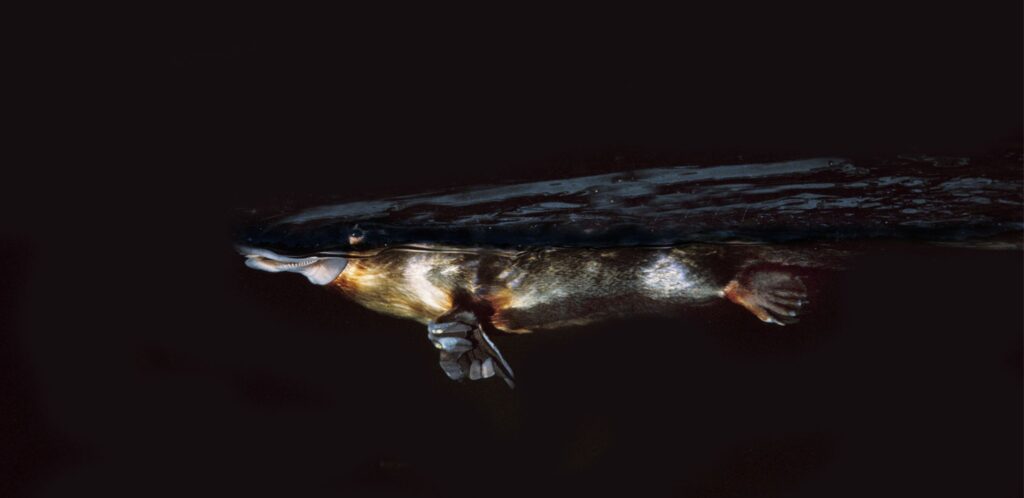15 November 2022
Wildlife Queensland has launched its annual Christmas appeal focused on a species that is arguably among the most bizarre in the world — the platypus (Ornithorhynchus anatinus). Considered a hoax when a specimen first came to the attention of English museum curator George Shaw in 1799, the platypus is the only living species in its genus.
Alongside the echidna, it is also the only other mammal in the order Monotremata — mammals that possess a single opening for defecation and reproduction, and which produce milk and lay eggs. In 2008, DNA sequencing revealed the platypus has a bizarre combination of reptilian and mammalian genetic characteristics. In short, it’s a living evolutionary oddity, and according to Tamielle Brunt, who heads Wildlife Queensland’s PlatypusWatch program, we risk losing its wonderful, one-of-a-kind weirdness if we don’t act to save it today.
“Platypus-like fossils first appeared in the Cretaceous period, about 110 million years ago,” explains Brunt, who has been known to refer to these stout burrowers as the all-terrain vehicles of Australia’s waterways. “They can be extremely tough, but that doesn’t mean they aren’t at risk. If anything, the fact that today’s platypus is the only living species in its genus makes it especially vulnerable to decline.”
In the 1900s, the platypus’s water-repellent pelt was highly prized in the fur trade. Although now protected, platypuses have vanished entirely from many suburban waterways along Queensland’s eastern coast as the human population swelled and irrigation, pollution and predation by introduced carnivores increased. Now, they’re again facing risks to their freedom of movement and the health and accessibility of their waterways as proposed new energy developments threaten known platypus strongholds.
No flow, no go …
In September this year, Queensland’s Palaszczuk Labor government announced that the state planned to become a hydro-electric powerhouse and proposed the resumption of some 50 pastoral properties in the Pioneer Valley, 75 km west of Mackay, to establish a 5-gigawatt pumped hydro energy storage (PHES) facility. The proposal, which follows on from a similar State government plan for Borumba Dam, near Imbil on the Sunshine Coast, is part of a $6.5 billion-dollar renewable energy plan but is yet to undergo ecological assessment, hydrological modelling, geological investigations and even Traditional Owner and local community consultation. The proposed reservoir, however, sits just north-east of a known platypus stronghold in peaceful Eungella National Park.
Although platypuses are listed as being of Least Concern in Queensland, researchers here and in other states have long had reason to believe they’re swimming under the radar.
“Eungella is one of very few places in Queensland where you have a fair chance of seeing a platypus in the wild,” says Tamielle. “But that might soon change. Platypuses, like so many of Australia’s species, are at risk from changing climate and from forecast increases in temperatures, droughts and bushfires,” she adds, “But loss of suitable habitat and connectivity is also a major concern for this species. We need clean, renewable energy, but proposals like this must still receive the same media and government scrutiny on environmental grounds when sensitive species are likely to be affected.”
Modern eDNA research into platypus occupancy of waterways helps researchers monitor platypus distribution with the aim of addressing threats like pollution and salinity of waterways, poor bank stabilisation, water temperature, food availability, and the control of feral predators. However, eDNA sampling alone — just to figure out which waterways contain platypuses — comes at a cost of around $200 per sample taken. Add data analysis and the on-ground costs of threat-mitigation, and platypus conservation doesn’t come cheap. Funding for biodiversity and species conservation remains much lower than the megabucks earmarked for infrastructure ‘mega projects’. Existing threats, coupled with a lack of funding plus infrastructure proposals that could exacerbate declines, spell very bad news for this uniquely duck-billed, webbed-footed, venomous, fur-covered iconic little battler.
Research published this month in the journal Nature by Jose Mijangos and colleagues Gilad Bino and Tom Grant at the University of New South Wales examined the disruption of gene flow between platypus groups in five areas near large dams and compared it with genetic differentiation in the species in waterways without dams. They found evidence of gene flow restriction starting from the year in which large dams were constructed, with the effect compounding in each subsequent generation, jeopardising long-term platypus population viability.
Such research suggests poor outcomes for local platypus populations in waterways set to be altered by large hydro-electric projects, or indeed anthropogenic activities relating to any kind of resource extraction or use, such as fracking or the release of polluted water from mining operations. Regarding the proposed hydro plant, a spokesperson for the Department of Energy and Public Works was quoted in an article in The Australian, titled ‘Queensland confident massive dam fits the platypus bill’, as saying, “We are committed to protecting our national parks and native animals; the project requires detailed environmental impact studies to be undertaken as part of the approvals process.”
The platypus has already run the gamut of human influence in so many ways. Wildlife Queensland’s appeal recognises that we all have a responsibility to correct that and to restore platypus populations, rather than reduce them further. Let’s hope State and Federal governments recognise the responsibility they have to ensure that this ancient, unique species remains at the forefront of their decision-making.
Donate to Wildlife Queensland’s appeal today at https://chuffed.org/project/protect-the-platypus

